Notre-Dame de Paris II
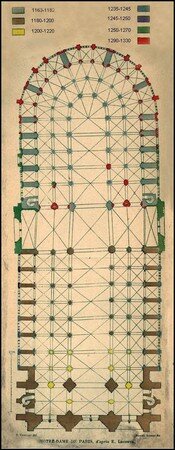 Like
the majority of the French cathedrals, Notre-Dame of Paris has a
outline drawing of Latin cross. Here are principal dimensions:
frontage, 40 meters; overall length in work, 130 meters; width from one
end to another of the transept, 48 meters; rise in the mistress arches,
35 meters; rise in the turns above the mistress arches, 34 meters;
total height of the turns, 69 meters; length of the chorus, 28 meters
out of 12 meters of width. Total surface, 6,240 square meters, giving a
cube of 218,400 meters in work, not included/understood the heightening
of the turns.
Like
the majority of the French cathedrals, Notre-Dame of Paris has a
outline drawing of Latin cross. Here are principal dimensions:
frontage, 40 meters; overall length in work, 130 meters; width from one
end to another of the transept, 48 meters; rise in the mistress arches,
35 meters; rise in the turns above the mistress arches, 34 meters;
total height of the turns, 69 meters; length of the chorus, 28 meters
out of 12 meters of width. Total surface, 6,240 square meters, giving a
cube of 218,400 meters in work, not included/understood the heightening
of the turns.
The cathedral contains 5 naves, 37 vaults, 3 pinks whose diameter is
for each one of 13 meters and half, 113 windows, 75 columns or free
pillars, not included/understood the imbedded columns, an up to date
platform reigning along the walls of the central nave, and from which
the bays are separated by 108 posts.
The nave comprises ten spans,
the chorus five. The axis of this one is slightly deviated compared to
the axis of the nave. The apse is semicircular with five sides. The
nave is flanked collateral doubles which are prolonged by a double
déambulatoire, the whole with side chapel (except on the first three
spans) and radiant (either 37 on the whole).
The nave
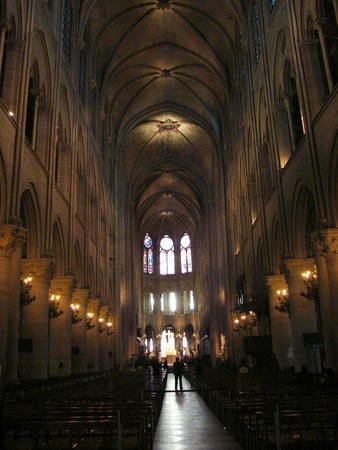 Built
before the chorus, the nave concerns the first Gothic style, with
sexpartite vaults, however without alternation of strong piles and weak
piles as one sees it in Sens.
Built
before the chorus, the nave concerns the first Gothic style, with
sexpartite vaults, however without alternation of strong piles and weak
piles as one sees it in Sens.
 The
transept, quite identifiable of the outside of the monument, does not
make not covered compared to collateral and the side chapel. It does
not have the collateral ones.
The
transept, quite identifiable of the outside of the monument, does not
make not covered compared to collateral and the side chapel. It does
not have the collateral ones.
Interior rise is on three levels, with large arcades, platforms and windows high.
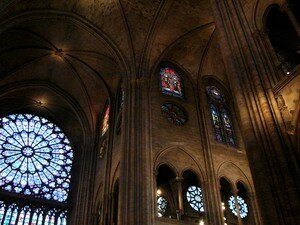 The
frontages north and south of the transept decorate splendid rosettes
decorated with stained glasses, among largest of Europe (diameter: 13
m).
The
frontages north and south of the transept decorate splendid rosettes
decorated with stained glasses, among largest of Europe (diameter: 13
m).
Turns
 With
the passing of years, it was suggested on several occasions that the
original plans of Notre-Dame envisaged two arrows which would rise
turns. The solids bell-towers could without any doubt have supported
such structures. But it is not in so far as they were supposed being
equipped with arrows. The cathedral of Amiens as of other cathedrals
followed the model of Notre-Dame and do not have either arrows
(however, the cathedral of Rheims should have had some, according to
initial plans', but they were never completed). During the restoration
which took place between 1844 and 1864, the idea of the arrows was
again suggested. The restorer Viollet-le-duc, wanting at all costs to
ruin the project, drew a very precise plan of the cathedral with such
arrows in order to show with the population the nightmarish result to
which this project would lead. Ironically, certain experts affirmed
since, on the basis of its plan, that Viollet-le-Duc was itself in
favour of these arrows.
With
the passing of years, it was suggested on several occasions that the
original plans of Notre-Dame envisaged two arrows which would rise
turns. The solids bell-towers could without any doubt have supported
such structures. But it is not in so far as they were supposed being
equipped with arrows. The cathedral of Amiens as of other cathedrals
followed the model of Notre-Dame and do not have either arrows
(however, the cathedral of Rheims should have had some, according to
initial plans', but they were never completed). During the restoration
which took place between 1844 and 1864, the idea of the arrows was
again suggested. The restorer Viollet-le-duc, wanting at all costs to
ruin the project, drew a very precise plan of the cathedral with such
arrows in order to show with the population the nightmarish result to
which this project would lead. Ironically, certain experts affirmed
since, on the basis of its plan, that Viollet-le-Duc was itself in
favour of these arrows.
The assymetry of the turns is generally due
to the cosmo-telluric forces passing under them. One is dedicated to
the sun, the other with the moon. Masculine, female, as in Chartres.
The gallery of the kings
 With
twenty meters of the ground, a series of twenty-eight royal characters
represents the twenty-eight generations of kings of Judée who preceded
Christ. Each statue measures more than three meters fifty top. The
heads of the statues date from the XIXth century and are the product of
the workshops of sculpture of the restorer Viollet-le-Duc. Indeed,
the statues of origin were decapitated in 1793 during the French
revolution by the Sans-culottes, who, wrongly, believed that these
statues represented sovereigns of the kingdom of France. There remain
today only fragments of the medieval statues. The original heads were
found in 1977, at the time of work undertaken for the restoration of
the Moreau hotel in IXth district of Paris, and are currently exposed to
the Museum of Cluny.
With
twenty meters of the ground, a series of twenty-eight royal characters
represents the twenty-eight generations of kings of Judée who preceded
Christ. Each statue measures more than three meters fifty top. The
heads of the statues date from the XIXth century and are the product of
the workshops of sculpture of the restorer Viollet-le-Duc. Indeed,
the statues of origin were decapitated in 1793 during the French
revolution by the Sans-culottes, who, wrongly, believed that these
statues represented sovereigns of the kingdom of France. There remain
today only fragments of the medieval statues. The original heads were
found in 1977, at the time of work undertaken for the restoration of
the Moreau hotel in IXth district of Paris, and are currently exposed to
the Museum of Cluny.
The gate of the Last Judgement
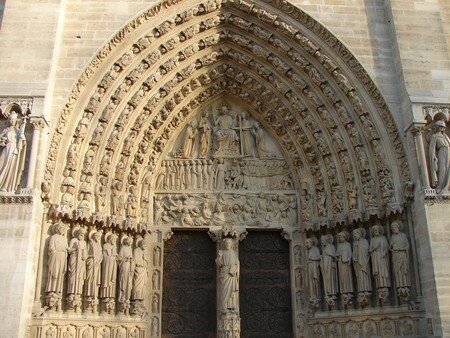 It
is about the principal gate of the cathedral. Its imagery is seizing.
It represents the last judgement - when, according to the Christian
tradition, deaths ressuscitent and are judged by Christ. On the lower
lintel, one can see deaths leaving their tombs. Above, an angel uses a
balance to weigh the sins and the virtues. The elected officials are on
the left, and, pushed on the right by demons with the diabolic glances,
damnés connected are carried out in hell. On the higher tympanum,
Christ chairs this divine court.
It
is about the principal gate of the cathedral. Its imagery is seizing.
It represents the last judgement - when, according to the Christian
tradition, deaths ressuscitent and are judged by Christ. On the lower
lintel, one can see deaths leaving their tombs. Above, an angel uses a
balance to weigh the sins and the virtues. The elected officials are on
the left, and, pushed on the right by demons with the diabolic glances,
damnés connected are carried out in hell. On the higher tympanum,
Christ chairs this divine court.
It is a quite concrete
demonstration of the Christian imagery developed with the Middle Ages
by the Church, which then influences largely people.
The scene of the Last Judgement is also reproduced on many other cathedrals.
The square
 The
square is the great open zone being right in front of the western
frontage. The word square comes from Latin paradisius, paradise. When
the cathedral was built, the square was rather narrow. The cathedral
was located among innumerable buildings out of wooden of small size,
such as houses, shops and inns. The square preserved modest dimensions
until the XVIIIth century, time to which the Beaufrand architect
increases it. It was reorganized on several occasions thereafter, in
particular since 1960.
The
square is the great open zone being right in front of the western
frontage. The word square comes from Latin paradisius, paradise. When
the cathedral was built, the square was rather narrow. The cathedral
was located among innumerable buildings out of wooden of small size,
such as houses, shops and inns. The square preserved modest dimensions
until the XVIIIth century, time to which the Beaufrand architect
increases it. It was reorganized on several occasions thereafter, in
particular since 1960.
The western frontage
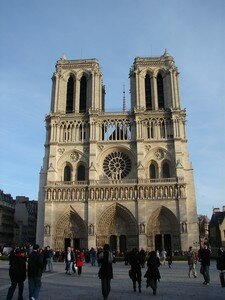 The
western frontage is large, at the same time rigorous and linear, in an
astonishing way the circle of the stained glass of the rosette
emphasizes. Many observers noticed that the general effect is similar
to that of a host. Three doors give access in the cathedral; vastest,
that of the medium, is called the door of the Judgement; on the left,
with the foot of the tower of north, the door of the Virgin opens; on
the right, the door Saint-Anne opens with the foot of the tower midday.
The
western frontage is large, at the same time rigorous and linear, in an
astonishing way the circle of the stained glass of the rosette
emphasizes. Many observers noticed that the general effect is similar
to that of a host. Three doors give access in the cathedral; vastest,
that of the medium, is called the door of the Judgement; on the left,
with the foot of the tower of north, the door of the Virgin opens; on
the right, the door Saint-Anne opens with the foot of the tower midday.
The gate of the Virgin
 This
gate is dedicated to the Virgin Mary. The Virgin Mary is in top of the
tympanum, sitting with the right-hand side of Christ; and an angel,
being above it, place a gold crown on its head. Note the pointed groove
in the wall around the arcs of the tympanum. The builders wanted that
this gate is different from different in the honor from the Virgin.
Above the pillar pier draws up a stone Virgin carved in XVth century,
coming from the old church of Saint-Aignan to the Cloister; it was
placed there in 1818; it replaces there a beautiful statue of XIIIth
century representing the Virgin carrying her son in his arms and
pressing with the feet the dragon, which was relegated, one does not
know when nor why, in the stores of the church of the chapter, in
Saint-Denis.
This
gate is dedicated to the Virgin Mary. The Virgin Mary is in top of the
tympanum, sitting with the right-hand side of Christ; and an angel,
being above it, place a gold crown on its head. Note the pointed groove
in the wall around the arcs of the tympanum. The builders wanted that
this gate is different from different in the honor from the Virgin.
Above the pillar pier draws up a stone Virgin carved in XVth century,
coming from the old church of Saint-Aignan to the Cloister; it was
placed there in 1818; it replaces there a beautiful statue of XIIIth
century representing the Virgin carrying her son in his arms and
pressing with the feet the dragon, which was relegated, one does not
know when nor why, in the stores of the church of the chapter, in
Saint-Denis.
The gate of Saint Anne
 This
gate, dedicated to the life of Saint Anne, the mother of the Virgin, is
known mainly because of the polemic concerning the two characters being
reproduced on the tympanum. Around a group including/understanding a
majestic Virgin holding Jesus-Christ child in his arms and two angels
two characters are: a bishop and a king. The tradition wants that these
characters represent the bishop Maurice de Sully, founder of
Notre-Dame, and Louis VII, king of France at the time. But certain
experts question this theory and support that the religious character
is Saint Germain, bishop of Paris to the Life century, and that the
king is Childebert Ist, wire of Clovis. Other experts even affirm that
these characters cannot be identified.
This
gate, dedicated to the life of Saint Anne, the mother of the Virgin, is
known mainly because of the polemic concerning the two characters being
reproduced on the tympanum. Around a group including/understanding a
majestic Virgin holding Jesus-Christ child in his arms and two angels
two characters are: a bishop and a king. The tradition wants that these
characters represent the bishop Maurice de Sully, founder of
Notre-Dame, and Louis VII, king of France at the time. But certain
experts question this theory and support that the religious character
is Saint Germain, bishop of Paris to the Life century, and that the
king is Childebert Ist, wire of Clovis. Other experts even affirm that
these characters cannot be identified.
The balcony of the Virgin
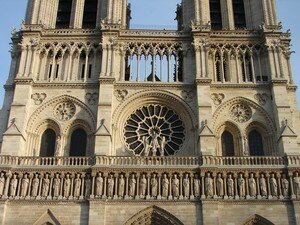 This
statue of the Virgin devotes the totality of the frontage to the mother
of Christ. She was ordered by Viollet-le-Duc to replace the original
statue of the medieval time, severely damaged by the climatic years and
conditions. The western rosette being behind this statue constitutes a
splendid aureole.
This
statue of the Virgin devotes the totality of the frontage to the mother
of Christ. She was ordered by Viollet-le-Duc to replace the original
statue of the medieval time, severely damaged by the climatic years and
conditions. The western rosette being behind this statue constitutes a
splendid aureole.
 Viollet-le-Duc
also placed statues of Adam and Eve in front of bays on each side of
the rosette. It acts there, according to the majority of the experts,
the principal error of Viollet-le-Duc in a restoration which, if not,
can be described as remarkable.
Viollet-le-Duc
also placed statues of Adam and Eve in front of bays on each side of
the rosette. It acts there, according to the majority of the experts,
the principal error of Viollet-le-Duc in a restoration which, if not,
can be described as remarkable.
 All seems to prove that no statue existed on this site. The statues of
Adam and Eve would have in fact due being placed in recesses of the
wall furthest away from the southern arm of the transept.
All seems to prove that no statue existed on this site. The statues of
Adam and Eve would have in fact due being placed in recesses of the
wall furthest away from the southern arm of the transept.
 The
Rose of the Virgin and her stone aureole: It is enough to be in the
good axis and with the passing necessary so that the Virgin, Notre Dame
finally, have the most memorable crown which is: a pink hones 9,60
meters in diameter, built between 1220 and 1225.
The
Rose of the Virgin and her stone aureole: It is enough to be in the
good axis and with the passing necessary so that the Virgin, Notre Dame
finally, have the most memorable crown which is: a pink hones 9,60
meters in diameter, built between 1220 and 1225.
This small
chief of work, of a great purity, is visible only of one precise point
of the square, to about thirty meters of the frontage. Let us remember
that at the Average Age, Notre Dame rose in the middle of the houses
and that the square had only one about thirty meters of depth. The
statue was thus placed on a pedestal very precisely calculated so that
the visitor, while leading to the place, is immediately struck by the
spectacle of the crowned Virgin… Yes, yes, that it is what the books
say! But…
But two small note: the prospect plays really only
when one further places oneself, place where houses rose; then, these
statues are not origin, but were drawn, like much, by Viollet-le-Duc.
Then… What imports, after all. The history is beautiful, even if it
lends a little too much to the genius our architects of the Middle Ages.
Rosettes
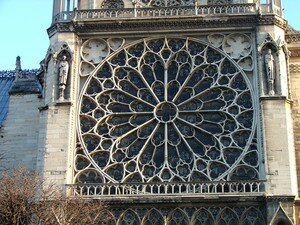 In
the Middle Ages, all the bays of Notre-Dame of Paris were furnished
with splendid stained glasses. All was destroyed at the 18th century,
except for the three large pinks, of exceptional quality. At the 19th
century, Viollet-le-Duc and his team created new stained glasses in
the medieval style for the side chapels and those of the déambulatoire.
In
the Middle Ages, all the bays of Notre-Dame of Paris were furnished
with splendid stained glasses. All was destroyed at the 18th century,
except for the three large pinks, of exceptional quality. At the 19th
century, Viollet-le-Duc and his team created new stained glasses in
the medieval style for the side chapels and those of the déambulatoire.
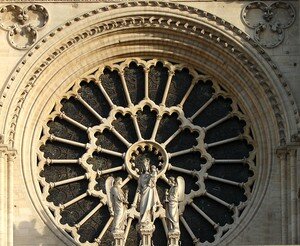 The
three large pinks of Notre-Dame of Paris are the Western pink (1220),
above the large organ which hiding place it with half, and the two
symmetrical pinks of the transepts North (1250) and South (1270) which,
according to the tradition, would have been given by Louis saint. The
stained glasses of the three pinks remained mainly of origin, in spite
of essential cleanings and restorations.
The
three large pinks of Notre-Dame of Paris are the Western pink (1220),
above the large organ which hiding place it with half, and the two
symmetrical pinks of the transepts North (1250) and South (1270) which,
according to the tradition, would have been given by Louis saint. The
stained glasses of the three pinks remained mainly of origin, in spite
of essential cleanings and restorations.
 The
Western pink consists of a central medallion representing the Virgin
with the Child, surrounded by three concentric circular bands. On the
basis of the center one first of all observes the series of the twelve
minor prophets, who announced the Incarnation of Jesus. The two
external circular bands oppose in top twelve virtues and twelve
defects; in bottom, they associate work of the months the twelve signs
of the zodiac. The number twelve, produced of three by four (three,
symbol of the Trinity, four, symbol of the terrestrial things) is the
symbol of the Incarnation.
The
Western pink consists of a central medallion representing the Virgin
with the Child, surrounded by three concentric circular bands. On the
basis of the center one first of all observes the series of the twelve
minor prophets, who announced the Incarnation of Jesus. The two
external circular bands oppose in top twelve virtues and twelve
defects; in bottom, they associate work of the months the twelve signs
of the zodiac. The number twelve, produced of three by four (three,
symbol of the Trinity, four, symbol of the terrestrial things) is the
symbol of the Incarnation.
 The
Northern pink is devoted to the Old Will. Its dominant violet is sign
of waiting and hope of the arrival of the Messiah. In three circles
eighty characters are represented: prophets, kings, judges and large
priests. In the center is again the Virgin with the Child, realization
of the promise and this fact junction between the Old one and the New
Will.
The
Northern pink is devoted to the Old Will. Its dominant violet is sign
of waiting and hope of the arrival of the Messiah. In three circles
eighty characters are represented: prophets, kings, judges and large
priests. In the center is again the Virgin with the Child, realization
of the promise and this fact junction between the Old one and the New
Will.
 The
Southern pink is that of the New Will, with dominant red and much more
luminous because of its orientation. It includes/understands
eighty-four medallions distributed on four circles and appear of the
apostles, the martyrs, of the bishops, as well as scenes of the Gospel.
The central medallion, creation of the workshop of Viollet-le-Duc,
represents the Christ of the Apocalypse surrounded of the tétramorphe.
The
Southern pink is that of the New Will, with dominant red and much more
luminous because of its orientation. It includes/understands
eighty-four medallions distributed on four circles and appear of the
apostles, the martyrs, of the bishops, as well as scenes of the Gospel.
The central medallion, creation of the workshop of Viollet-le-Duc,
represents the Christ of the Apocalypse surrounded of the tétramorphe.
The
open-type screen under the two pinks represents one eighteen kings de
Juda, the other the sixteen prophets, the four of the bearing center on
their shoulders the four evangelists. These stained glasses were remade
at the 19th century by the workshop of Viollet-le-Duc.
The gate of Saint Étienne
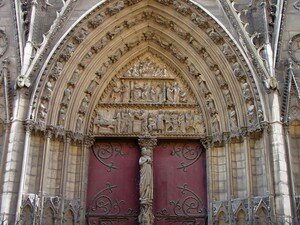 This door is at the level of the southern arm of the transept. The tympanum
tells the life of the first Christian martyr, Saint Étienne, according
to Acts' of the Apostles.
This door is at the level of the southern arm of the transept. The tympanum
tells the life of the first Christian martyr, Saint Étienne, according
to Acts' of the Apostles.
The gate of the cloister
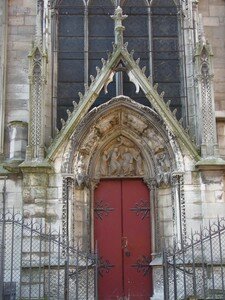 This
gate is at the level of the northern arm of the transept. The lower
lintel represents scenes of the childhood of Christ. These sculptures
are among the most beautiful works carved on this topic.
This
gate is at the level of the northern arm of the transept. The lower
lintel represents scenes of the childhood of Christ. These sculptures
are among the most beautiful works carved on this topic.
The red gate
The project superintendent Pierre de Montreuil built this small door, called for obvious reasons “the red gate”, between 1250 and 1270. Louis IX, better known under the name of Louis Saint, had commissioned it. He is presented on the tympanum of the Virgin, crowned on the left by an angel. The wife of Louis Saint, Marguerite of Provence, is on the right of Christ.
Southernmost gate of Notre-Dame of Paris
 The
door of the Virgin, as the door Saint-Anne or of the South, is furnished
with admirable ornaments or strap hinges out of wrought iron, which
cover the casements with wood. Worked in light arabesques, flowers and
foliages, rinceaux and animal, they hold the first rank among the
capital parts of the iron work in XIIth and XIIIth centuries. They arise
gracefully on the red coating with which one covered the casements.
These wonders of the art of the wrought iron are so beautiful that the
people did not want to believe that they had been carried out by the
hammer of a simple blacksmith. This one would have had recourse to the
devil, which was worth the nickname of Biscornette to him. But the
assistance of malignant did not serve as nothing for the central door
by which Blessed Sacrament leaveleaves the days solemnity; Biscornette
never managed to shoe it, It appears that the architects nowadays used
of more powerful magic spells, because they shoed the large door with
strap hinges very skilfully copied from the side doors.
The
door of the Virgin, as the door Saint-Anne or of the South, is furnished
with admirable ornaments or strap hinges out of wrought iron, which
cover the casements with wood. Worked in light arabesques, flowers and
foliages, rinceaux and animal, they hold the first rank among the
capital parts of the iron work in XIIth and XIIIth centuries. They arise
gracefully on the red coating with which one covered the casements.
These wonders of the art of the wrought iron are so beautiful that the
people did not want to believe that they had been carried out by the
hammer of a simple blacksmith. This one would have had recourse to the
devil, which was worth the nickname of Biscornette to him. But the
assistance of malignant did not serve as nothing for the central door
by which Blessed Sacrament leaveleaves the days solemnity; Biscornette
never managed to shoe it, It appears that the architects nowadays used
of more powerful magic spells, because they shoed the large door with
strap hinges very skilfully copied from the side doors.
The apse
 The
apse is consisted a half-circle located in the part more at the east of
the cathedral. It was built during the first phase of construction, of
1163 to 1180. A series of propping up admirable supports its wall
higher round-off. It is decorated with sculptures and panels
representing inter alia episodes of the life of the Virgin.
The
apse is consisted a half-circle located in the part more at the east of
the cathedral. It was built during the first phase of construction, of
1163 to 1180. A series of propping up admirable supports its wall
higher round-off. It is decorated with sculptures and panels
representing inter alia episodes of the life of the Virgin.
The roof
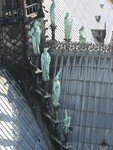 In
his will, Maurice de Sully left the sum of five thousand sums of money
for the roof of the cathedral, which was covered only with temporary
materials until its death in 1196. The roof is covered with 1326 lead
tiles. The total weight of these tiles is estimated at more than two
tons.
In
his will, Maurice de Sully left the sum of five thousand sums of money
for the roof of the cathedral, which was covered only with temporary
materials until its death in 1196. The roof is covered with 1326 lead
tiles. The total weight of these tiles is estimated at more than two
tons.
The arrow
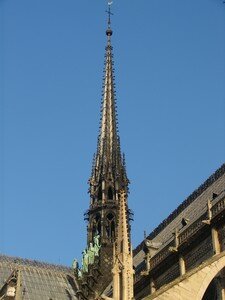 The
first arrow was built above transept crossing in the middle of XIIIth
century. Such high arrows suffer from the wind which folds and weakens
their structures. The arrow is deformed slowly, the solids are
distorted, until the total collapse. The arrow of origin was dismounted
in 1786, after more than five centuries of existence. The cathedral
remained without arrow until the restoration directed by
Viollet-the-Duke in the middle of the XIXth century. This arrow is kept
by the statues of the 12 apostles (had in four lines - at each cardinal
points - 3 apostles, those Ci being placed the one below of the
others). All are turned towards Paris, except one of them, Pierre. That
Ci resembles curiously Viollet-the-Duke, the architect of the arrow. It
is a small historical joke of this large architect and restorer.
The
first arrow was built above transept crossing in the middle of XIIIth
century. Such high arrows suffer from the wind which folds and weakens
their structures. The arrow is deformed slowly, the solids are
distorted, until the total collapse. The arrow of origin was dismounted
in 1786, after more than five centuries of existence. The cathedral
remained without arrow until the restoration directed by
Viollet-the-Duke in the middle of the XIXth century. This arrow is kept
by the statues of the 12 apostles (had in four lines - at each cardinal
points - 3 apostles, those Ci being placed the one below of the
others). All are turned towards Paris, except one of them, Pierre. That
Ci resembles curiously Viollet-the-Duke, the architect of the arrow. It
is a small historical joke of this large architect and restorer.
The bell
 The
large bumblebee whose speaks François Villon in his Grant Testament,
gone back to 1461, had been given in 1400 to the cathedral by Jean de
Montaigu, brother of the bishop of Paris, which had baptized it
Jacqueline, of the name of his Jacqueline wife of the Barn. Jacqueline
was remelted in 1686 by foundry foremen Chapelle, Gillot, Moreau and
Florentin Guay, and accepted a new baptism in the name of
Louise-Marie-Thérèse, queen of France, woman of Louis XIV. Jacqueline
weighed only fifteen thousands (7,500 kilogrammes). Marie-Thérèse
weighs a little more of the double (16,000 kilogrammes or 16 tons
metric). The leaf only weighs with him 485 kilogrammes. The thickness
of the bell is 28 cm; the perimeter is 4 meters. A Latin inscription,
placed in relief, reports its adventures and its transformations.
The
large bumblebee whose speaks François Villon in his Grant Testament,
gone back to 1461, had been given in 1400 to the cathedral by Jean de
Montaigu, brother of the bishop of Paris, which had baptized it
Jacqueline, of the name of his Jacqueline wife of the Barn. Jacqueline
was remelted in 1686 by foundry foremen Chapelle, Gillot, Moreau and
Florentin Guay, and accepted a new baptism in the name of
Louise-Marie-Thérèse, queen of France, woman of Louis XIV. Jacqueline
weighed only fifteen thousands (7,500 kilogrammes). Marie-Thérèse
weighs a little more of the double (16,000 kilogrammes or 16 tons
metric). The leaf only weighs with him 485 kilogrammes. The thickness
of the bell is 28 cm; the perimeter is 4 meters. A Latin inscription,
placed in relief, reports its adventures and its transformations.
 The bumblebee “Emmanuel-Louise-Marie-Thérèse” is located in top of the
422 steps of the southern Tower. One racconte that when it was remelted
in 1631, the women threw in the molten metal their gold jewels, giving
to the bell its single tone in F sharp.
The bumblebee “Emmanuel-Louise-Marie-Thérèse” is located in top of the
422 steps of the southern Tower. One racconte that when it was remelted
in 1631, the women threw in the molten metal their gold jewels, giving
to the bell its single tone in F sharp.
It sounds only with the
great festivals of the year: Christmas, Branches, Easter, the Rise,
Pentecost, the Assumption and All Saints' day, like at the time of
exceptional ceremonies.
Four other bells are in the Northern tower
since 1856, to replace those of the Average Age sent to the cast iron
in 1791 to make guns.
They sound three times per day for the Angelus
at 8 a.m., 12 hours and 19 hours and also for the Office cathédral in
week. Sundays and feastdays, they sound with 9h 45 and 15h 45.
The flight “with the cord” was replaced by the use of pedals at the 19th century.
Maintaining the ringing is operated by remote control electrically.

/https%3A%2F%2Fprofilepics.canalblog.com%2Fprofilepics%2F1%2F1%2F116167.jpg)
/https%3A%2F%2Fstorage.canalblog.com%2F49%2F16%2F312499%2F14620054_o.jpg)
/https%3A%2F%2Fstorage.canalblog.com%2F53%2F18%2F312499%2F14151229_o.jpg)
/https%3A%2F%2Fstorage.canalblog.com%2F07%2F05%2F312499%2F14149867_o.jpg)
/https%3A%2F%2Fstorage.canalblog.com%2F11%2F35%2F312499%2F14149307_o.jpg)
/https%3A%2F%2Fstorage.canalblog.com%2F90%2F14%2F312499%2F14125247_o.jpg)


/https%3A%2F%2Fstorage.canalblog.com%2F12%2F98%2F137895%2F6624411_p.jpg)
/https%3A%2F%2Fstorage.canalblog.com%2F34%2F82%2F137895%2F27207854_p.jpg)
/https%3A%2F%2Fstorage.canalblog.com%2F32%2F37%2F137895%2F15872299_p.jpg)
/https%3A%2F%2Fstorage.canalblog.com%2F37%2F81%2F137895%2F15879822_p.jpg)